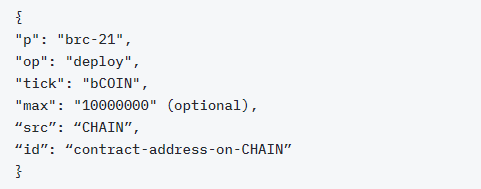What is BRC 21? BRC 21 is a standard created to address the limitations of previous standards, especially BRC 20. So what is the BRC 21 standard and what is special? Let’s find out with Weakhand in this article. Please.
Before jumping into the article, you can read some of the following articles to understand better.
- What is BRC 20? All you need to know about BRC 20
- What is Bitcoin Ordinals? Everything about Bitcoin Ordinals
What is BRC 21?
Amid the rapid development of Blockchain technology and cryptocurrencies, the development of various token standards will play an important role in enabling the creation of diverse digital assets. The BRC 21 standard has emerged as an innovative advancement in the Bitcoin ecosystem.
The BRC 21 standard is designed to address the limitations of previous standards, especially BRC 20. Tokens that adopt the BRC 21 standard offer more advanced functionality, allowing developers to deploy features like transaction privacy, scalability, and interoperability. This standard leverages advanced cryptographic techniques to achieve higher levels of security while maintaining interoperability with existing Blockchain networks.
BRC Operating Model 21
BRC 21 Standard From a technical perspective, the BRC 21 standard should rely on three components and the entire process is expected to achieve complete decentralization:
- Indexer: Customize validation of Bitcoin BRC 21 minting, transfers, and redemptions as well as Contract state on the source chain.
- Source Chain Contract: Handles token minting and reverse token swap operations on the source chain.
- BTC – Relay: A BTC client is deployed as a Smart Contract on the source chain, capable of verifying operations including BTC transactions and parsing them.
Next, the deployment of BRC 21 tokens is still similar to the BRC 20 operating model, including the following fields:

Fields in BRC 21 standards
However, there are some minor modifications:
- Max field set option: Maximum supply defined on the source chain. Specifying it during BRC 21 implementation is therefore optional but can serve as a fallback measure.
- Lim fields introduced in the BRC 20 standard will be removed for extensibility reasons. Since tokens applying the BRC 21 standard are subject to minting and redeeming rules, there is no need to impose a limit on the number of tokens that can be created in a single transaction.
- Src field is added to specify the token’s source string. It can be a chain like Ethereum or a unique integer identifier.
- The Id field is added to serve as the unique identifier of the token on the source chain. For example: Contract ERC 20 address on Ethereum.
The operating model of BRC 21 tokens will be as follows:
- First, users who own tokens such as: ETH, SOL, DOT,… can deposit into the platform to mint BRC 21 tokens and the initial tokens will be locked in Smart Contract.
- It will then mint bCOIN tokens as the BRC 21 standard on the Bitcoin network.
- When users want to receive their original tokens back, Burn bCOIN tokens will take place and then unlock ETH, SOL,… tokens for users.
BRC Use Case 21
This standard is used to mint and exchange BRC 20 tokens to/from Bitcoin first created on other source chains such as Ethereum (ETH, DAI,….), Cosmos or Polkadot,.. This means users can transfer assets such as: ETH, DAI, DOT,… to Bitcoin and vice versa from Bitcoin to Blockchains Ethereum, Cosmos,…
Although it is possible to use the BRC 21 standard to create assets representing ETH, DOT, SOL,…. on the Bitcoin network. But the main proposed use case for this standard is the implementation of decentralized StableCoins on the Lightning Network or similar payment protocols.
Decentralized StableCoins such as MakerDAO’s DAI, Liquity’s LUSD, etc. require complex minting, redemption, and liquidation mechanisms to maintain their peg levels fixed. Since Bitcoin does not support Smart Contracts, these protocols cannot be implemented directly on Bitcoin. So the idea of this method is to create wrap sessions of assets on the Bitcoin network and allow end-to-end Bridges from Bitcoin to Blockchains containing those assets.
Compare BRC 20 and BRC 21 Standards
While both the BRC 20 and BRC 21 standards play key roles in Bitcoin’s ecosystem, they serve distinct purposes. The BRC 21 token has a higher level of complexity and flexibility so it caters to applications that require advanced features such as privacy and scalability. On the other hand, although the BRC 20 standard still has many shortcomings in its design, it is still a foundational standard, facilitating simple token creation and trading on the Bitcoin blockchain.
summary
The BRC 21 standard was created to overcome some of the shortcomings of the BRC 20 standard. As the Bitcoin ecosystem grows, the emergence of new solutions is extremely necessary. Above is all the information I want to introduce in this article, hope everyone has received useful knowledge.


